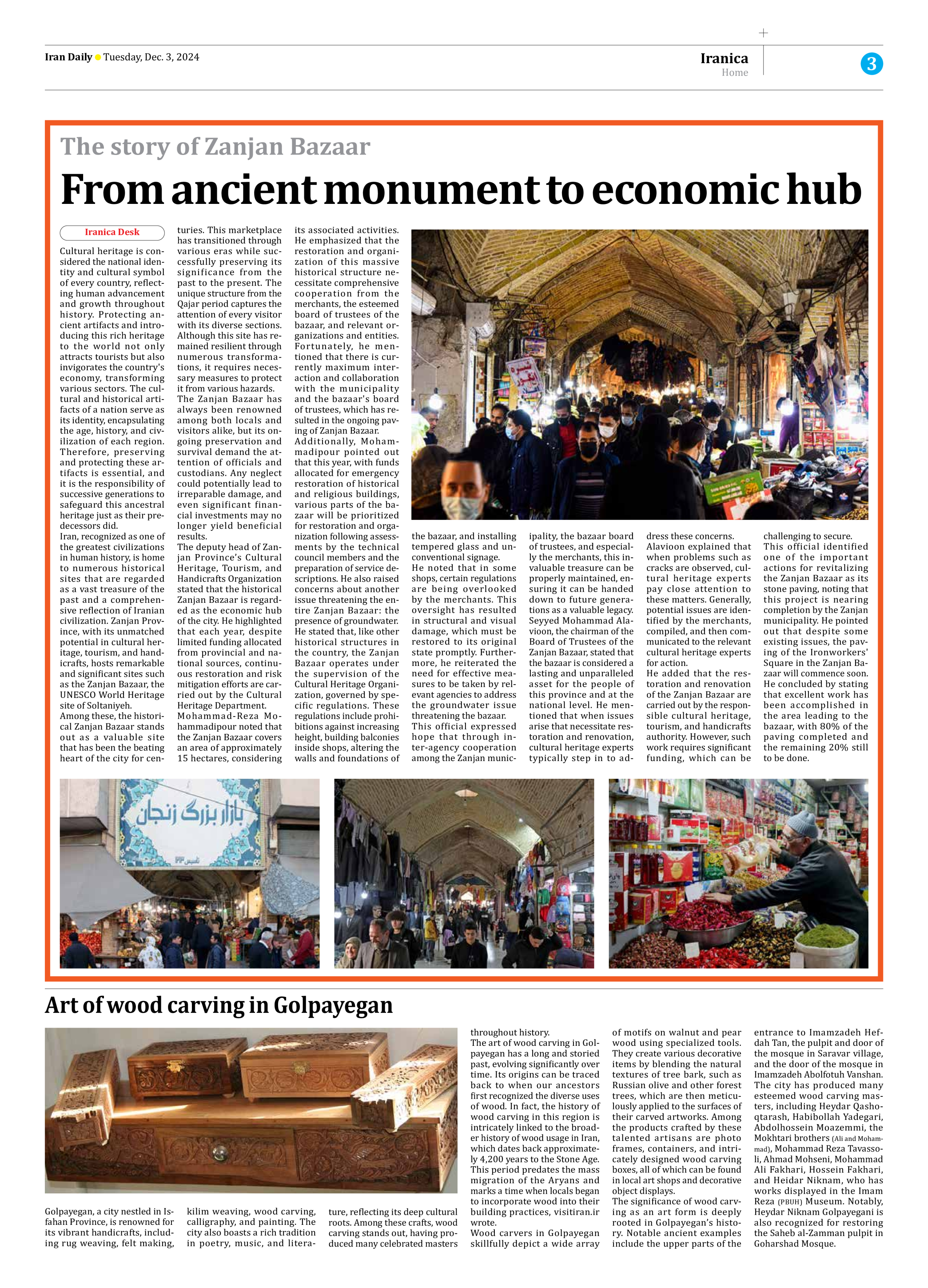
The story of Zanjan Bazaar
From ancient monument to economic hub
Cultural heritage is considered the national identity and cultural symbol of every country, reflecting human advancement and growth throughout history. Protecting ancient artifacts and introducing this rich heritage to the world not only attracts tourists but also invigorates the country's economy, transforming various sectors. The cultural and historical artifacts of a nation serve as its identity, encapsulating the age, history, and civilization of each region. Therefore, preserving and protecting these artifacts is essential, and it is the responsibility of successive generations to safeguard this ancestral heritage just as their predecessors did.
Iran, recognized as one of the greatest civilizations in human history, is home to numerous historical sites that are regarded as a vast treasure of the past and a comprehensive reflection of Iranian civilization. Zanjan Province, with its unmatched potential in cultural heritage, tourism, and handicrafts, hosts remarkable and significant sites such as the Zanjan Bazaar, the UNESCO World Heritage site of Soltaniyeh.
Among these, the historical Zanjan Bazaar stands out as a valuable site that has been the beating heart of the city for centuries. This marketplace has transitioned through various eras while successfully preserving its significance from the past to the present. The unique structure from the Qajar period captures the attention of every visitor with its diverse sections. Although this site has remained resilient through numerous transformations, it requires necessary measures to protect it from various hazards.
The Zanjan Bazaar has always been renowned among both locals and visitors alike, but its ongoing preservation and survival demand the attention of officials and custodians. Any neglect could potentially lead to irreparable damage, and even significant financial investments may no longer yield beneficial results.
The deputy head of Zanjan Province’s Cultural Heritage, Tourism, and Handicrafts Organization stated that the historical Zanjan Bazaar is regarded as the economic hub of the city. He highlighted that each year, despite limited funding allocated from provincial and national sources, continuous restoration and risk mitigation efforts are carried out by the Cultural Heritage Department.
Mohammad-Reza Mohammadipour noted that the Zanjan Bazaar covers an area of approximately 15 hectares, considering its associated activities. He emphasized that the restoration and organization of this massive historical structure necessitate comprehensive cooperation from the merchants, the esteemed board of trustees of the bazaar, and relevant organizations and entities. Fortunately, he mentioned that there is currently maximum interaction and collaboration with the municipality and the bazaar's board of trustees, which has resulted in the ongoing paving of Zanjan Bazaar.
Additionally, Mohammadipour pointed out that this year, with funds allocated for emergency restoration of historical and religious buildings, various parts of the bazaar will be prioritized for restoration and organization following assessments by the technical council members and the preparation of service descriptions. He also raised concerns about another issue threatening the entire Zanjan Bazaar: the presence of groundwater.
He stated that, like other historical structures in the country, the Zanjan Bazaar operates under the supervision of the Cultural Heritage Organization, governed by specific regulations. These regulations include prohibitions against increasing height, building balconies inside shops, altering the walls and foundations of the bazaar, and installing tempered glass and unconventional signage.
He noted that in some shops, certain regulations are being overlooked by the merchants. This oversight has resulted in structural and visual damage, which must be restored to its original state promptly. Furthermore, he reiterated the need for effective measures to be taken by relevant agencies to address the groundwater issue threatening the bazaar.
This official expressed hope that through inter-agency cooperation among the Zanjan municipality, the bazaar board of trustees, and especially the merchants, this invaluable treasure can be properly maintained, ensuring it can be handed down to future generations as a valuable legacy.
Seyyed Mohammad Alavioon, the chairman of the Board of Trustees of the Zanjan Bazaar, stated that the bazaar is considered a lasting and unparalleled asset for the people of this province and at the national level. He mentioned that when issues arise that necessitate restoration and renovation, cultural heritage experts typically step in to address these concerns.
Alavioon explained that when problems such as cracks are observed, cultural heritage experts pay close attention to these matters. Generally, potential issues are identified by the merchants, compiled, and then communicated to the relevant cultural heritage experts for action.
He added that the restoration and renovation of the Zanjan Bazaar are carried out by the responsible cultural heritage, tourism, and handicrafts authority. However, such work requires significant funding, which can be challenging to secure.
This official identified one of the important actions for revitalizing the Zanjan Bazaar as its stone paving, noting that this project is nearing completion by the Zanjan municipality. He pointed out that despite some existing issues, the paving of the Ironworkers' Square in the Zanjan Bazaar will commence soon. He concluded by stating that excellent work has been accomplished in the area leading to the bazaar, with 80% of the paving completed and the remaining 20% still to be done.







